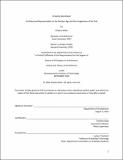Drawing Apocalypse: Architectural Representation in the Nuclear Age and the Imagination of the End
Author(s)
Keller, Eliyahu
DownloadThesis PDF (57.75Mb)
Advisor
Hyde, Timothy
Terms of use
Metadata
Show full item recordAbstract
The use and development of atomic weapons have been determining factors in shaping the history of the twentieth century. Throughout the Cold War, and primarily in the United States, images of the unprecedented devastation of Hiroshima and Nagasaki were coupled with visual and literary fictions projecting the aftermath of a world-ending atomic war. These fostered an atmosphere in which the possibility of the world’s end was not only real but imminent; a nuclear apocalyptic cloud which permeated almost all facets of cultural production, including that of architecture.
This dissertation examines the ways in which nuclear apocalyptic thinking, imagination, and discourse contaminated speculative architectural representation in the decades that followed World War II. Stepping away from the pragmatic responses proposed by architects, planners, and institutions to the nuclear threat, it first theorizes the role of architectural images in the construction of apocalyptic fictions and visualizations. Following, this dissertation studies the speculative architectural propositions, representations and narratives produced by three US-based architects: Paolo Soleri, Raimund Abraham, and Lebbeus Woods.
Focusing on the representational paradoxes that apocalyptic thinking and imagination suggest—namely, the impossibility of representing an all-encompassing end—the dissertation explores the threat of nuclear apocalypse not as a problem to be solved by architecture, but rather as a discursive and historical lens through which architectural thinking can be reframed. To that end, the dissertation places the works examined within a constellation of nuclear-age discourses, cultural artifacts, and historical events, and interprets them through the lens of nuclear criticism: a field of literary critique that explores the relationship between the human potential for self-annihilation and cultural production. With that, the dissertation investigates how the imagination of a nuclear apocalypse fostered a kind of end-times preoccupation within speculative architectural production, and the ways in which these propositions both drew from and participated in the construction of nuclear apocalyptic culture during and after the decades of the Cold War. By doing so, the dissertation addresses a gap in architectural thinking in relation to an epistemology of disaster and unearths an apocalyptic current within postmodern architectural production that has yet to be addressed. Out of this investigation, the works examined emerge as testimonies to the limits of architectural imagination at a moment in history when the possibility of the future itself was at stake.
Date issued
2022-09Department
Massachusetts Institute of Technology. Department of ArchitecturePublisher
Massachusetts Institute of Technology